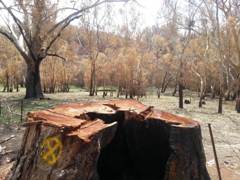24 April 2015
 Initial findings from a bushfire study underway in the Adelaide-Mount Lofty Ranges and Lower Eyre Peninsula has found only 70 per cent of residents in those areas have a Bushfire Action Plan in mind, despite 97 per cent perceiving a level of bushfire risk.
Initial findings from a bushfire study underway in the Adelaide-Mount Lofty Ranges and Lower Eyre Peninsula has found only 70 per cent of residents in those areas have a Bushfire Action Plan in mind, despite 97 per cent perceiving a level of bushfire risk.
The finding is among initial data gathered by researchers from the University of South Australia and University of Adelaide, who have spent the past 12 months exploring the balance between conservation values and perceptions of bushfire risk in the two peri-urban regions. Both regions have been hit by catastrophic fires in recent years, including the Sampson Flat fire in January.
Key partners in the study are the SA Government through the Department of Environment, Water, and Natural Resources (DEWNR) and two regional Natural Resource Management Boards (Adelaide-Mount Lofty Ranges and Eyre Peninsula).
Chief Investigator, UniSA’s Professor Guy Robinson, says destructive fires in urban fringe areas are reframing perceptions of what constitutes effective vegetation management and how this can be balanced so it achieves conservation outcomes and maintains the values that make these places so attractive and important to people.
“The research is innovative because we asked residents not only about bushfire preparedness but also about conservation attitudes and values,” he says.
“We are now analysing the data from 1000 survey responses and six workshops with key stakeholder groups. Our results show that the vast majority (97 per cent) perceive some level of bushfire risk where they live, but only 70 per cent have a Bushfire Action Plan – and that includes both formal and informal plans.”
The University of Adelaide’s Douglas Bardsley says the findings suggest there is growing tension between urban development and the need to both manage bushfire risk and conserve biodiversity.
“Seventy-two per cent do not want to see more housing developments where they live – they choose to live on the urban fringe primarily for the good environment it offers for bringing up children, for its relaxed lifestyle, and as an escape from urban life,” he says.
Initial analysis also suggests residents place highest values on their surroundings being weed-free and providing opportunities to see or hear wildlife, with 62 per cent wanting to see more native vegetation throughout the Adelaide-Mount Lofty Ranges and Lower Eyre Peninsula. On average, residents reported they were more satisfied with the current management of bushfire risk than the current management of vegetation where they live.
In response to the Sampson Flat fire, the researchers will conduct further surveying in the northern Adelaide Hills in April and July to examine perceptions at three months and six months after a major fire.
They will also conduct workshops with CFS staff and volunteers.
Surveys will be sent to random households but individuals interested in participating are also invited to contact emily.moskwa@unisa.edu.au.
The project has been funded for three years by a $236,486 Australian Research Council Linkage grant and almost $1 million in partner cash and in-kind contributions.
DEWNR’s Fire Management team hopes the findings will improve the Department’s understanding of the community’s values and expectations with regard to fire management and biodiversity conservation and help guide the development of community engagement programs throughout South Australia.
Contact for interview: Chief Investigator Prof Guy Robinson (UniSA) mobile 0434 181 279
Dr Douglas Bardsley (University of Adelaide) mobile 0447 315 212
Media contact: Kelly Stone office 8302 0963 mobile 0417 861 832 email Kelly.stone@unisa.edu.au
Or David Ellis (University of Adelaide) office 8303 5414 email david.ellis@adelaide.edu.au




